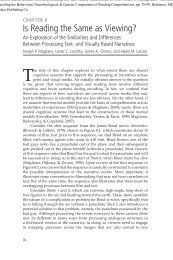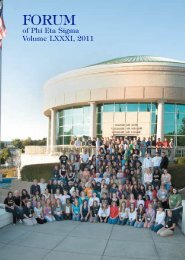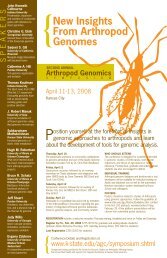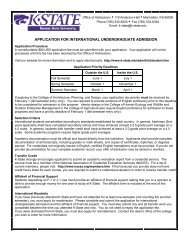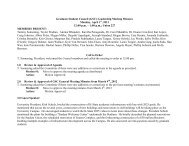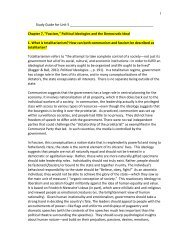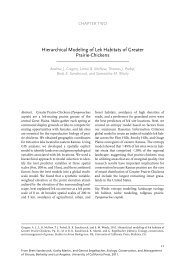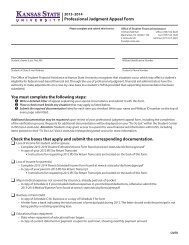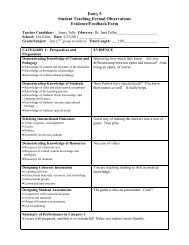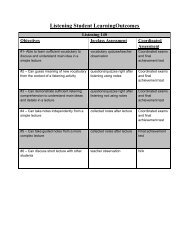Estimation of Demographic Parameters from Live ... - BioOne
Estimation of Demographic Parameters from Live ... - BioOne
Estimation of Demographic Parameters from Live ... - BioOne
You also want an ePaper? Increase the reach of your titles
YUMPU automatically turns print PDFs into web optimized ePapers that Google loves.
whereas the same parameter was underestimated as ^/ N B ¼<br />
0.31 with a standard multi-strata model. Combined multistrata<br />
and robust design models have been used by Bailey et<br />
al. (2004a) and Skvarla et al. (2004) to estimate demographic<br />
parameters for tiger salamanders (Ambystoma<br />
tigrinum) and banner-tailed kangaroo rats (Dipodomys<br />
spectabilis), respectively.<br />
Nichols et al. (2004) dealt with uncertainty in sex<br />
determination by developing a modified multi-strata model<br />
for 2 sampling scenarios. Investigators construct encounter<br />
histories for uncertain-strata models by either treating every<br />
capture occasion as an independent attempt to assign strata,<br />
or by assuming that strata assignments do not change once<br />
they have been determined. The uncertain-strata model<br />
yields the usual estimates <strong>of</strong> apparent survival and encounter<br />
rates, but also estimates a classification parameter (d), the<br />
strata-specific probability that an individual is classified with<br />
certainty, and a mixture parameter (p), the probability that<br />
an unmarked individual belongs to one <strong>of</strong> the known strata.<br />
Transition rates (w) are not estimated. This model provided<br />
some <strong>of</strong> the first sex-specific estimates <strong>of</strong> apparent survival<br />
for roseate terns (Sterna dougallii), a species <strong>of</strong> conservation<br />
concern where the sexes are difficult to distinguish in all age<br />
classes.<br />
One past concern for multi-strata models was the lack <strong>of</strong> a<br />
reliable test for assessing fit <strong>of</strong> a global model, but new<br />
goodness-<strong>of</strong>-fit procedures (Pradel et al. 2003, 2005) and<br />
accompanying s<strong>of</strong>tware are now available (Program U-Care;<br />
Choquet et al. 2003). The main limitation <strong>of</strong> multi-strata<br />
models is that the number <strong>of</strong> parameters (K) to be estimated<br />
increases rapidly if investigators include a large number <strong>of</strong><br />
categorical states in the encounter histories or if they use<br />
memory models. Complex multi-strata models may require<br />
substantial amounts <strong>of</strong> data and adequate computer<br />
resources for fitting the log-likelihood function. Thus,<br />
multi-strata models are usually restricted to a maximum <strong>of</strong><br />
2–4 states. For example, Brown et al. (2003) observed<br />
colonies <strong>of</strong> sociable weavers (Philetairus socius) that ranged<br />
<strong>from</strong> ,2–.500 individuals, but they reduced this variation<br />
to 3 categories to model the effects <strong>of</strong> colony size on<br />
apparent survival. Similarly, Drake and Alisauskas (2004)<br />
marked a large sample <strong>of</strong> Ross’s geese (n ¼ 3,233 adults<br />
[Chen rossii]), and attempted to model /, w, and p as a<br />
function <strong>of</strong> colony (5 levels), sex (2), and year (4 intervals).<br />
They did not detect inter-colony movements for 99 <strong>of</strong> 160<br />
possible transitions in a 5-strata model, and they collapsed<br />
the number <strong>of</strong> colony strata <strong>from</strong> 5 to 3 before proceeding<br />
with further analyses.<br />
Joint Models for Combined Sources<br />
<strong>of</strong> Information<br />
Joint models combine live-encounter data with either<br />
radiotelemetry or dead-recovery information. Investigators<br />
can use joint models to estimate survival with greater<br />
precision, and to estimate other useful demographic<br />
parameters as well. Multi-strata models are one possible<br />
approach for combining different sources <strong>of</strong> information<br />
(Lebreton et al. 1999, Williams et al. 2002), and<br />
investigators have used multi-strata models to combine<br />
information <strong>from</strong> banded and radiotagged wood thrushes<br />
(Hylocichla mustelina; Powell et al. 2000), hair samples <strong>of</strong><br />
unmarked and radiomarked grizzly bears (Ursus arctos;<br />
Boulanger et al. 2004), and live-encounter and deadrecovery<br />
data <strong>from</strong> multiple sites (Kendall et al. 2006). In<br />
the first 2 studies, the authors treated different marker types<br />
as separate groups and the core and peripheral regions <strong>of</strong> a<br />
study site as strata in the encounter histories. They then<br />
used multi-strata models to estimate movement rates and<br />
the marker-specific values <strong>of</strong> / and p.<br />
Investigators have developed specialized models for joint<br />
analysis <strong>of</strong> live-encounter and radiotelemetry data (Nasution<br />
et al. 2001, 2004) and live-encounter and dead-recovery data<br />
(Burnham 1993, Barker 1997, 1999). In the Burnham and<br />
Barker models, encounter histories have one value for each<br />
type <strong>of</strong> information per occasion (i.e., LD format; Fig. 1).<br />
<strong>Live</strong> encounters usually are taken <strong>from</strong> a small sampling<br />
area, but dead recoveries are reported <strong>from</strong> a much larger<br />
geographic region, which reduces losses to permanent<br />
emigration. Thus, one major advantage <strong>of</strong> joint models<br />
based on live encounters and dead recoveries is that apparent<br />
survival can be decomposed into the probabilities <strong>of</strong> true<br />
survival (S) and site fidelity (F).<br />
The Burnham model estimates 4 parameters: S, F, and the<br />
probabilities <strong>of</strong> capture (p) and reporting (r) for live and<br />
dead animals, respectively (Fig. 1). Lindberg et al. (2001)<br />
extended the Burnham model by placing it in a robust<br />
design framework. In addition to S, F, p, and r, the closed<br />
population elements <strong>of</strong> this model allow estimation <strong>of</strong> 3<br />
other parameters: the probability <strong>of</strong> recapture (c), and the<br />
conditional probabilities <strong>of</strong> temporary emigration (c9 and<br />
c99). The Barker model combines encounter data <strong>from</strong> 3<br />
separate sources: live encounters, dead recoveries, and live<br />
resightings between encounter occasions. In addition to S,<br />
F, p, and r, the Barker model estimates 3 more parameters:<br />
the probabilities <strong>of</strong> live resighting (R), resighting before<br />
mortality (R9), and immigration (F9). The Barker model<br />
has also been extended to estimate demographic parameters<br />
corrected for possible tag loss (Conn et al. 2004) and for<br />
temporary emigration (Barker et al. 2004).<br />
Investigators have mainly applied the Burnham and Barker<br />
models to hunted species <strong>of</strong> gamebirds: lesser prairie-chickens<br />
(Tympanuchus pallidicinctus; Hagen et al. 2006), dabbling<br />
ducks (Anas strepera, Szymczak and Rexstad 1991; 3 spp.,<br />
Blums et al. 2002; Anas platyrhynchos, Doherty et al. 2002),<br />
diving ducks (Aythya valisineria, Lindberg et al. 2001; Aythya<br />
americana, Arnold et al. 2002; Bucephala clangula, Ludwichowski<br />
et al. 2002; 3 spp., Blums et al. 2005), sea ducks<br />
(Melanitta nigra; Fox et al. 2003), geese (Chen caerulescens,<br />
Cooch et al. 2001; Branta and Anser spp., Alisauskas and<br />
Lindberg 2002; Branta bernicla, Sedinger et al. 2002; Chen<br />
rossii, Slattery and Alisauskas 2002; Anser spp., Fredericksen<br />
et al. 2004), and cormorants (Phalacrocorax carbo; Fredericksen<br />
and Bregnballe 2000). However, applications <strong>of</strong> joint<br />
models to nongame species are growing in number. The<br />
Sandercock Mark–Recapture Analyses <strong>of</strong> <strong>Live</strong>-Encounter Data 1513



